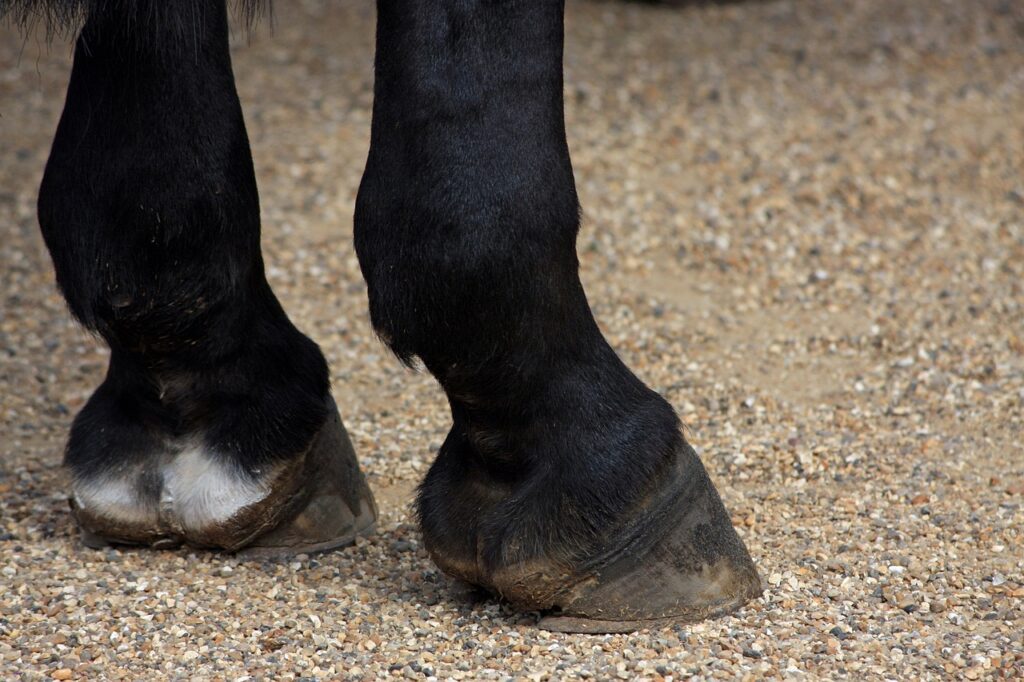Thrush and what you can do about it
Every horse owner knows it and has had to deal with it at least once – thrush.
Thrush is a bacterial disease of the horse’s hoof. The soft frog horn of the hoof is decomposed by putrefactive bacteria.
Consequences of thrush
If thrush is not treated, the disease can spread to the surrounding tissues and cause blood poisoning in the horse. However, the horse’s body defends itself so strongly against this bacterial infection that damage to organs and tissue can occur. Preventing thrush is therefore particularly important.


How do I recognize thrush?
Thrush is relatively easy to recognize when the horse is cared for regularly. Particularly typical is the foul odor that becomes noticeable when the hooves are scratched out and/or a dark liquid escapes in the process. If you are unsure whether frog rot is present, you can simply press a cotton swab into the frog furrow and if this becomes saturated with a dark liquid, then an infection is present.
Other signs include cavities forming in the frog of the hoof and a detaching horn.
Causes and treatment
Poor hygiene is the most common cause of infection. A poorly mucked-out horse stall, for example, is a paradise for the bacteria, since the dung accumulates, among other things, feed residues, damp straw and hay, as well as feces and urine. So if not mucked out well, the horse’s hoof also softens due to the constant moisture and thus becomes more susceptible to bacteria found in the dung.
However, grooming, such as scraping the hoof, also contributes massively to the prevention of infections, as it prevents the bacteria from settling.
However, if an infection occurs despite hygiene measures, thorough cleaning and subsequent avoidance of moisture is necessary.

With Sanocyn forte: 5 steps to cleaning
Sanocyn forte is a pH-neutral solution for wound cleansing. It is based on a new technology, HOCL (hyperchlorous acid), which is safe for humans and animals, as this acid is also used in natural defense processes. Thus, the preservative HOCL in Sanocyn forte does not damage healthy tissue and is extremely effective in eliminating viruses and bacteria:
- carefully clean affected areas with a hoof scraper
- spray hoof and frog generously with the Sanocyn forte hoof, skin and wound solution and thus rinse them
- allow Sanocyn forte solution to dry in for optimum effect
- then spray with Sanocyn forte hoof, skin and wound hydrogel for prolonged protection of the wound area
- apply several times a day
Share this article:

Papillomas in horses
Papillomas, also known as warts, are a common viral skin disease in horses. They are caused by the equine papillomavirus (EPV), which is highly contagious and can be transmitted between horses through direct contact or contaminated equipment. While papillomas are not usually a serious health concern, they can be unsightly and can cause discomfort or irritation for the horse.

Cats and heat
Cats are known for their love of warmth and sunshine, but when temperatures soar, our feline friends can face some challenges. As a cat owner, it’s important to understand how cats cope with heat and what you can do to help them stay cool and comfortable during hot weather.

Summer travel with your dog
Summer is a great time to hit the road with your furry friend and explore new destinations together. However, traveling with a dog requires some extra planning and preparation to ensure a safe and enjoyable trip for both you and your four-legged companion. In this article, we will provide some helpful tips and advice for traveling with a dog during the summer.

Sunburn in horses
Sunburn is a common issue that can affect horses during the summer months, especially those with light-colored hair or pink skin. In this article, we’ll discuss what causes sunburn in horses and how you can prevent and treat it.

Itchy skin on your pet?
One of the most occurring reasons to visit a vet is itchy skin. It is an urgent problem that causes discomfort for the pet as well as for its owner. If you identify itchy skin in your pet, you should make an appointment with your veterinarian. Let’s discuss what you should expect from your appointment.
